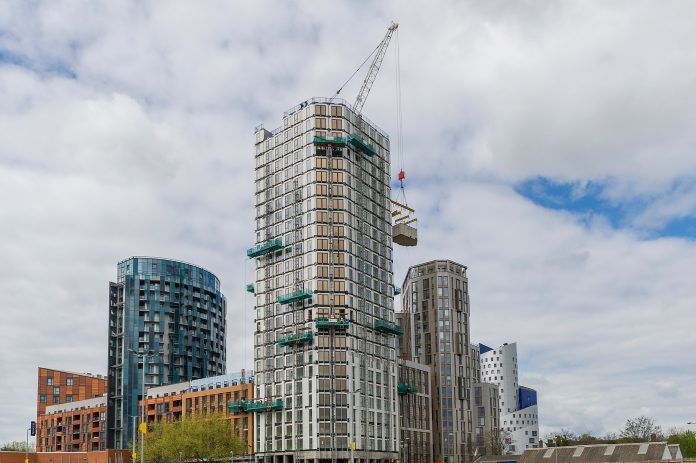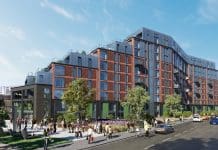Modern Methods of Construction offer the opportunity to rethink how homes are designed and built – and speed up delivery of much-needed properties, yet they currently account for only a small percentage of new housing
Is a potential revolution being held back by an outdated planning system?
Modern Methods of Construction (MMC) have been touted as a game-changer for a decade, yet only around 10% of new homes are built using them, despite the UK needing millions more properties in the coming years.
Most analysis has previously centred on financial and technical barriers but a recently published report from engineering, design and planning specialist Arup argues that the planning system is too rigid and unaccommodating to really drive forward MMC at scale.
The case for MMC
MMC, as defined by the government’s cross-industry working group, covers a range of different technologies that all use offsite manufacturing to speed up construction. These include timber frame systems, prefabricated pods that are incorporated within traditional builds and volumetric modular systems. Arup’s study says MMC can achieve a number of key planning policy objective for housing:
- Faster construction: Factory-made components and systems are not affected by delays on site. MMC can reduce on-site construction times by as much as half compared to traditional bricks-and-mortar methods.
- An increase in the overall number of homes: MMC are well-suited to the traditional market, custom- and self-build homes, social housing and build-to-rent. An estimated 265,000 extra dwellings could be delivered in the next 10 years if a third of new homes used MMC.
- Market absorption rates are maintained: MMC can offer alternative products to the market, completing the traditional offer, rather than competing with it. It also brings increased choice and the opportunity for more innovative designs. A common complaint about the cyclical nature of the existing residential sales-led model is that housebuilders drip-feed homes to the market to help maintain price.
- Meeting annual targets: The long lead-in times for traditional housing schemes make it increasingly difficult to meet five-year supply requirements. As a result, councils face the penalty of the NPPF’s “presumption in favour of sustainable development” and loss of control. The faster construction and absorption of MMC homes can help resolve this.
- Variety and flexibility: The digital approach to MMC design enables mass customisation. They offer a solution for almost every site and scale of project because of the variety of systems and materials available and the interchangeability of many components.
- Reducing impacts on existing residents: MMC can cut deliveries to site and disruption. They offer particular advantages for small, restricted sites, infill sites and estate intensification.
- Build quality: Precision-engineered, factory-control production means MMC offer consistently high build quality, offering reassurance to the public, as well as the opportunity to be more sustainable.
Smoothing the development management process
Despite the many benefits of MMC, planning delays and planning risk are consistently cited as some of the biggest challenges faced by developers.
“There’s evidence which shows the current planning system cannot deliver MMC at scale, nor does it understand the opportunities it brings,” said Vicky Evans, Arup’s UKMEA residential business leader.
“Developers, local authorities and Homes England must now work together to change attitudes to introduce a streamlined planning process that supports innovative housebuilding.”
The calls on local planning authorities to consider adopting a “pattern book” approach, a system used in the 18th and 19th centuries to allow architects, builders and homebuyers to share and popularise designs.
Within a design code, this could establish parameters for style, daylighting/fenestration and space standards, the report argues. Implemented using a Local Development Order (LDO) could indicate the scale of development and site layout, reducing risk for developers and providing more certainty over planning timescales.
Planning also has a role in ensuring and maintaining high design standards, the report says. It adds that the principles of offsite construction are not new, but have suffered from image problems, historically being seen as poor quality, low aspiration, temporary structures, which “all too often reinforced longer-term social mobility problems for residents.”
The successful rollout of MMC depends on the homes they deliver being both desirable to potential residents and attractive to existing communities.
“In general, the public accept that more new homes need to be built – but on the condition of high-quality design,” the report said.
“Local authorities, designers and manufacturers have a responsibility to ensure this.”
Arup calls for Homes England to appoint an MMC “design champion” and for the Building Better, Building Beautiful Commission should work with developers, applicants and local authorities to highlight examples of excellent design in MMC.
A shift in attitudes
The report argues that a streamlined, risk-minimising approach will only work if there is also a shift in the attitudes of some local planning departments.
The advantages of a new MMC planning model will be eroded if planning officers and councillors seek to “tweak” designs, it warns, and design decision need to be locked in early on and carried through.
While not all MMC homes have to be identical, there is a reliance on replicable processes and making minor amendments is not easy. This makes the value of pre-application engagement is therefore more important than ever.
There should also be training for planning officers and council members on MMC and their benefits, as well as a pragmatic approach to local labour conditions being applied to planning permissions, as the efficiency of MMC is based on centralised construction systems. While some on-site labour is required, MMC providers often deploy their own teams, who are familiar with the product and can ensure quality assurance requirements are achieved.
Harnessing digital innovation
Technology such as virtual reality and BIM should be used by developers and applicants to showcase MMC products to address lingering historic perceptions and encourage public support, the report says.
In addition, it calls on local authorities and developers to create a benchmark assessment tool to quickly assess the viability of MMC proposals, review the benefits of MMC for a particularly site and identify places where they can be used.
Digital can also be used to allow buyers to customise their homes, supported by local authorities through design codes and LDOs.
MMC can also contribute to the wider digital transformation of the planning system, with MMC digital designs reducing the burden on planning departments, streamlining the process and speeding up decisions, the report adds.
Katie Kerr, Arup town planner and co-author of the study, said: “We see a future system where paper-driven planning applications are replaced with designs direct from digital platforms, selected by the buyer and pre-agreed with the local council and, once consented, are sent straight to the production line.”
Driving the MMC revolution
Partnerships will be crucial to MMC’s success and local authorities are well placed to lead pilot schemes on their land, the report says.
“As relatively new entrants to the housing market, they are not constrained by existing supply chains so they can flex their buying power to promote MMC,” it adds.
“The success of such partnerships depends on tangible support for the concept from the local authority, councillors, MPs and political leaders.”
The report concludes that MMC should have a vital role in tackling the housing crisis and, while doing so, they can meet key planning policy objectives, such as increasing the variety of homes and speeding up development, enabling properties to be built on brownfield or awkward sites, improving quality and reducing disruption.
“The MMC revolution is already underway,” it says.
“Now, to enable it to become widely used, all parts of the housing system need to align – and planning is a vital component of this.”
The report highlights several examples of planning policy being used to encourage MMC.
Stratford-upon-Avon District Council
The council has drawn up a development required supplementary planning document (SPD), currently subject to public consultation, that sets out the requirements for modular development, including how it should comply with wider design principles.
It encourages careful consideration of external appear and cladding to ensure it harmonises with the surrounding area and pre-application engagement with case officers.
Wakefield District Council
In 2018, Wakefield introduced a Residential Design Guide SPD setting out the different types of MMC and encouraging applicants to “take advantage of the latest technologies to improve building quality”.
Central Bedfordshire Council
The council’s Local Plan 2035 sets out an aim of having MMC account for 20% of all new development of the period it covers. Developers will be specifically asked to demonstrate how they have considered the use of MMC.














